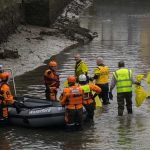The Bathing Water Directive (2006/7/EC) was transposed into Irish law…
Tuam Tidy Towns tells the story of the River Nanny
Tuam Tidy Towns are telling the tale of the rich biodiversity of the Nanny in their “Story of the River”. The group have been busy researching what species may live in their local river and have put together a highly detailed graphic illustration and colouring book for national school pupils to learn about each species.
The importance of a healthy river is not lost on the group who have illustrated the abundance of life in a “lotic freshwater ecosystem” image below. Tuam Tidy Towns will also host a “The Story of the River colouring competition” for school children.

The project will be launched by Gordon D’Arcy and coincides with the International Day of Biological Diversity (May 22nd) as part of National Biodiversity Week.
For further details tune check out the launch which can be viewed on the Tuam Tidy Town Facebook page.
This project has been supported by Galway Atlantaquaria, and the Local Authority Waters Programme. The poster was illustrated by Garry Kendellen.
The story of the River Nanny by Tuam Tidy Towns
This is the story of the interactions of animals and plants that live in a river habitat. The Story of the River poster shows a very simple version of that habitat. The part played by insects in this and indeed other habitats is not well known or understood and it is the purpose of this poster to change that.
All the higher animals, including fish, birds, bats and otters depend, either directly or indirectly on these insects for food; thus, these insects have intrinsic importance.
There are 25,000 species of insects in Ireland. They are close to the base of the food chain. A study in Germany found that insects have declined by 75% in the last 30 years. At present, 26% of birds in Ireland are on the national Red List of highest conservation concern.

Macroinvertebrates
The word macroinvertebrates describe the organisms that live in the bed of a river and includes worms, snails, and beetles but we are just considering some flying insects common to all river sites. Macroinvertebrates that become flies are an important part of what makes a river habitat work. They live in the riverbed and eat all the detritus and leaves that get washed into rivers and thus speed up its decomposition by 1000 times. If you walked on the bed of a river in November, you would see that it is matted with decaying leaves. Or if you witnessed the floods that occur at that time of year and saw all the water cluttered with detritus so much that it is cloudy. Have you ever wondered how the same river is as clean as a whistle the following spring? Well, it wasn’t all washed away, it was eaten by macroinvertebrates. So, you see they are cleaners of the river and they make it habitable for other species.
They are an essential layer of the food pyramid. All species higher in the pyramid rely on them for food, directly or indirectly. Their wellbeing affects every other species in the habitat. It is worth noting that by observation of the range of macroinvertebrates that live in a river, you can discover how clean or polluted the river is.
The species in the poster represent hundreds of species rather than just the five mentioned, Mayfly, Caddis fly, Stonefly, Midge, Dragonfly. All start as eggs and go through several stages of nymphs and at the last minute of their lives, so to speak, hatch out as flies in order to mate and start the whole process again. Dragonflies are predators of all the other species and live the longest, up to five years as macroinvertebrates and up to 3 weeks as flies. Midges are at the other end of the scale, a few months as macro invertebrates and a few hours as flies.
If pollution kills these insects, then the whole ecosystem is adversely affected. The type of insects that live in a river directly points to its state of cleanliness or pollution. At this time 2021 from the source in Cartoon to the Garda Station in Tuam the quality of water in the Nanny River changes from good to moderate status and is monitored by the EPA (Water Quality in Ireland 2013-2018). We must all support each other in protecting and improving the water quality of the Nanny.
– Michael Waldron, Tuam Tidy Town Chairman








